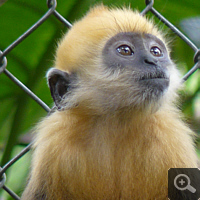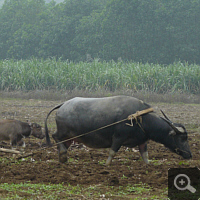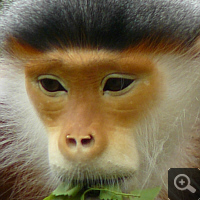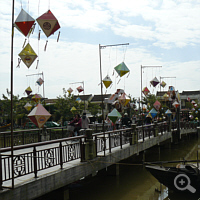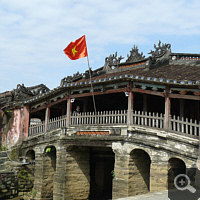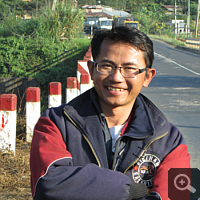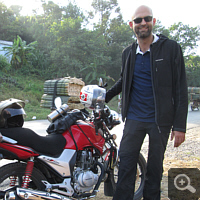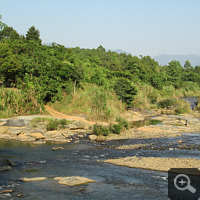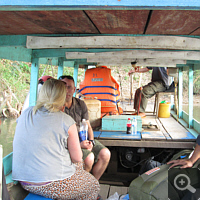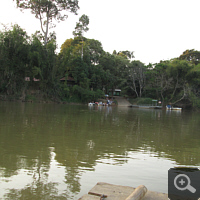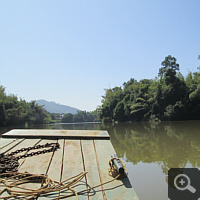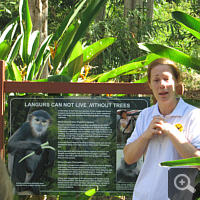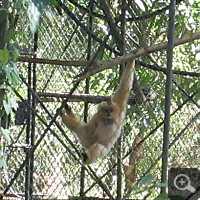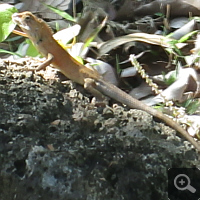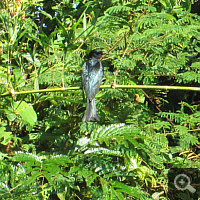
Travelog Vietnam journey 2013
Gentle reader.
For a long time I have hesitated with publication of my diary. For my honesty’s sake it is neccessary to adhere to my own deficiencies and to deal fairly with them.
I went backpacking in Vietnam for two weeks: Equipped with a rough itinerary and an outward, domestic and inward flight booked in advance. Everything else I decided und organised on impulse. I experienced two wonderful weeks. Was deeply involved into biological field work, was a guest of Indochina’s leading monkey researcher, saw extremely rare primates in the wild, had My Son for my own, undertook trips with Easy Riders for several days and experienced the entire culinary range of the Vietnamese cuisine, that reached from inedible up to superlunary.
After two very impressive weeks I had bad luck in the end. Not because I was confronted with mafia-like structures, but rather due to own scattiness. My camera was stolen and simultaneously I lost all by then taken photos. Nevertheless same could have happen to me in Germany.
That these web pages feature yet still some photos, it is on the one hand because my acquaintance kindly supplied me with some of her photos [Incidentally once more: Thanks a lot.], I copied her some of mine on her laptop during holiday and I bought finally a compact camera in Vietnam.
If you should dispose of some photos that fit in thematically to my travelog, so I would be very pleased if you would provide me with those for a publication on this web page. Of course I will provide your photos with respective photo credits.
Prologue
So far Vietnam was for me more a black hole on the world map than a serious travel destination. In the case of Vietnam raised immediately associations with washed-up US-veterans and Agent-Orange-impaired Vietnamese. What should I go there? Until a distant acquaintance of mine set out just there to start her diploma thesis about Delacour’s langurs. Already the fact, that years ago I had once considered to study biology myself and had now the opportunity to get to know live biological field work, aroused my interest.
Well – in all honesty, I knew langoustes, but langurs? Due to Google this gap in education was quickly closed and simultaneously my interest aroused. Thus far it escaped my notice that Vietnam has in complete Indochina highest biodiversity of primates, among that also Delacour’s langurs rank (more precisely they belong to the group of lutungs). Among these are 5 species, which count to the 25 world’s most endangered primates. But apart from this, species inventory is a who-is-who: tiger, elephant, pangolin, gaur, Asian black bear, clouded leopard, Siamese crocodile, countless bird and turtle species – to name exemplarily but a few.
But the country looks also back on a turbulent history, which precisely does not start at the Vietnam Wars or at colonial time. This is shown by the fantastic ruins of My Son or the imperial city Hue. With supposed 500 dishes and mobile cookshop everywhere is the country culinary as much multifarious as scenic. Regarding this, potpourri ranges from the world-famous Halong Bay to during war deforested areas and evergreen rainforest to the Mekong delta and palm-fringed sand beaches.
Therefore I set out for a two weeks‘ backpacker tour …
Arrived and prompt fooled (day 1, 05.01.2013)
I drive with the taxi from the airport to Hanoi’s downtown. Some days later I will realize that I have already after a few minutes walked right into the first Vietnamese trap: Overtired tourists are almost compelled by taxi drivers at the airport exit into their rip-off machine. Once you are seated, then the hotel tips out of the guidebook are run down (overpriced, since days booked out, noisy quarter, etc.). Instead he would know a good, cheap hotel. My weary, jet lag-stricken brain does not consider the circumstance of a commission-motivated volubility of the driver and finally I accept also a supposed high taxi bill in the case of a probably manipulated taximeter. But some days later at the domestic flight I will be more alert …
At first I sleep my jet lag off, afterwards I start then a scouting expedition of Hanoi. In the close proximity is the Ngoc-Son-temple located. Nevertheless it teems in Vietnam with temples and pagodas, so that this temple is not relevant.
In Hanoi you notice much more distinctly than recently in Indonesia the emergent economic nation. Vietnamese are spiffy dressed. At the streets stand closely together shoe – and clothing stores, in that – apart perhaps from the dress size – also fashion-conscious Europeans could easily make a find. As pedestrian self-organisation of the traffic chaos gets your attention once again: Total tirades of motorbikes, whose paths cross perfectly from all four cardinal directions, without to draw just somewhat too near. Only me as European, who is used to zebra crossings and pedestrian lights, remain a disturbing factor in this organised chaos. Finally – after a while of observation of the Vietnamese – I have also the courage to cross a four-lane street. Eyes half-closed I cross slowly, but with constant speed the street.
Gradually the cold night is approaching. Every few metres soars sedulously the vapour from the pots of the small cookshops at the street corners and allures with the fine bouquet of Vietnamese spices and herbs. Hunger silences hygienic scruples and I seat eventually myself in one of the cookshops. Well, actually I worm my long legs under a tiny table and try to balance on a low kindergarten stool. But it is worth it, thr food is delicious. From all pots I let serve me something by the old cookee. When by her smile her already sun-tanned skin is enhanced by some additional wrinkles, also my last doubts are cleared up and I enjoy the delicious with mince stuffed bell peppers and cabbage rolls.
Culinary highlights (day 2, 06.01.2013)
This afternoon I will go by the public service vehicle in Cuc Phuong National Park. In the morning I explore once more Hanoi’s old quarter, whose streets are themed with shops. In one are only silk goods offered, in another only spices, in the next paints or for example metal goods. Once more, I stop in a cookshop and start my day Vietnamese- classically with a delicious soup: Pho Bo, a noodle soup with beef, consisting of a soup stock made from cattle bones, shallots, ginger, fish sauce, cardamum, star anise, Chinese cinnamon – in combination with ribbon noodles, beef and also many fresh herbs as for instance coriander.
Gradually it becomes serious. I leave to the local bus station Giap Bat in the south of Hanoi. The receptionist calls a „taxi“, that turns out to be a xe om – one of this motorbike taxis. At first raise my hackles. Yesterday I observed the traffic yet adoringly from the side, today I shall become a part from that. What the heck! Thus helmet on and mounted on the motorbike. Now it goes quicksilver through Hanoi’s alleys and highways southwards. The longer the journey takes, the more I enoy that.
Although already forewarned, I am über die Verhältnisse at the bus station somewhat irritated. Approximately one dozen drivers talk insistently to me without interruption and attempt talkatively to convince me, that their bus is the one. But I stand pat and fight me into the giant ticket hall. After a search for several minutes I find finally the right counter, buy a bus ticket and let me note the license plate number of ‚my‘ bus. Thus provided I proceed to the behind located parking area and scour about one hundred buses for the right license plate number.
On highways it goes to the south. After circa two hours drive we reach Van Long, where my acquaintance actually gets on then. However, the bus stops approximately 15 kilometres before the destination. Because we are together with a Vietnamese girl the last passengers, full discussions flare up, whether the continuation of the journey as far as the destination would be worthwhile anyway. Thus we are initially ungallantly thrown out of the bus, to be after all transported after some discussions to the destination. In Cuc Phuong National Park we let fade away the evening at circa 10 °C on the terrace with two beers.
Woken by melodious gibbon’s songs (day 3, 07.01.2013)
The day starts typically Vietnamese. I get up at 06:30 Uhr, roundabout is already busy hurly-burly. Vietnameses go to bed early, but also get up at the crack of dawn. After rising from bed a melodious song out of the forest astonishes me, whereby must certainly be about gibbons, whose musicality is in fact amazing. For breakfast it gives an instant-imitation of the Pho Bo, that can in no way compete with the quality of Hanoi’s soup kitchens.
At first we visit the Endangered Primate Rescue Centre (EPRC). This is spacious area, which acts as station of last resort for langurs and gibbons. In dozens cages are there in total way above 100 primates, which partly live for more than 20 years in the EPRC. That is the actually frightening thing. The EPRC is not a simple intermediate station to a life in freedom, but rather for many primates a home in perpetuity, because suitable biotopes, which offer permanently safety, are missing or primates are such disturbed or mutilated, that they could not survive any longer in the wild. Again the problems become very plainly clear, in that nature protection is. Critically endangered species let them protect permanently probably only in facilities like the EPRC. A species conservation in freedom strikes me in the long run as illusorily.
The langurs fascinate me. How cute they are yet. During my visit of the EPRC the gibbons strike up repeatedly their melodious songs. The gibbon song is started by a male, then further gibbons join in the choir, before the song is terminated by a female.
Then we visit the Turtle Conservation Center. Asia is an absolut hotspot of turtle-biodiversity. Nevertheless turtles are to no degree less endangered as langurs. Just as those they end up in pots as delicacy or are used in the traditional Chinese medicine. Therefore many species face very soon their extinction too. Due to the icy temperatures in the last days the turtles were collected from the enclosures and keep in a cottage a kind of dormancy.
Then, in the afternoon, we rent two mountainbikes, with which we explore Cuc Phuong National Park. However, for this national park we have definitely chosen the false season of year. Now, in winter at just above 10 °C is neither to see something of the orchid abundance nor of the myriads of butterflies. At a stone cave, in which the remains of a 7.500-year-old human were found, we finally turn back.
Finally at dusk we visit yet the centre for carnivores and pangolins, that are nocturnal. This centre is not accessible for normal tourists. In this centre are kept especially leopard cats, civets, diverse viverrid species and pangolins. I am totally fascinated by the latter. These curious creatures, that look like oversized fir cones, give me at first the impression to be quite clumsy. With which elegance then one of these animals skims yet over the trunks, astounds me then though enormously. It is repeatedly amazing, what curious creatures inhabit our Earth.
After supper it goes with the taxi to the Van Long Nature Reserve. The hotel, in which I check in, has definitively seen better days yet. Empty buildings, crumbling plaster and an illumination with coloured striplights. All in all the charm of my home of the next days is between that of a abandoned Sowiet-barrack and that of a budget-brothel. Whatever! The bed is warm and clean.
Practical training in biological field works (day 4, 08.01.2013)
Today I will get a ‚ short course ‚ in biological field studies. But first I brace myself with a breakfast that matches the ambience of the hotel. To be allowed to get into the depths of the nature reserve, I have at first to introduce myself personally in the headquarter. Dude! Is that a procedure. The chief, two representatives of the forest authority as well as some other Vietnamese sit together with us. It is made some small talk, drunk green tea and studied my passport and visa for several minutes. Eventually the okay is given. Now it goes with the motorbike in the nature reserve. Szenery is fantastic and gives the impression that a Chinese landscapist had placed the area in this North Vietnamese region. Behind an extensive wetland with gorgeous kingfishers and multitudes of other waterfowls is a primeval seeming lake nestled in rugged, mist-shrouded limestone peaks. These are the habitat of the extremely rare Delacour’s langurs – a species, that with approximately 200 in the wild surviving individuals counts to the 25 world’s most endangered primates. These black primates with their incredible long tail and a white colouring in the region of waist and butt, which somehow still look as would they wear a white nappy, bother only humans. It is us, who will have eradicated this species soon. All of us who are with 8 billions individuals the most widespread primate species worldwide. With an incredible intelligence blessed we have conquered even the last, still such hostile to life corner of Earth and represent thus the black rat or cockroach of the primate world.
A forlorn scenery presents today. Dense fog patches wrap up the limestones like cotton wool. In addition to that drizzle and the cold airflow that confronts one during the ride on the motorbike. Definitely is a visit of Van Long in January unadvisable, albeit the travel time from March to May might provide a fantastic ambience.
After some kilometres ride we arrive. Some weeks ago, a Delacour’s langur-pair was in Van Long Nature Reserve returned to the wild. Both specimens were equipped with a GPS-sender-collar. We start with the pinger signal. This is superbly strong, the GPS-download works promptly. We try now to catch sight of the primate male. For hours we scour the foot fo the limestone slope, gaze up over and over into the fog. But nothing – no trace of the chap! Later, after analysis of the GPS-data, it will become apparent that the male was all the time only 200 m away from us.
In the evening we study the recorded GPS-data. At first the female has stayed for some days in the proximity of the release site, before she has moved at a good pace out of the Nature Reserve. Then, after some further days the collar became abruptly silent. Presumably the poor succumbed to poachers, although a malfunction of the collar is also not to except. By contrast, the male moves within a small area, which maybe 2 x 3 km comprises.
A boat trip – or modern colonialism (day 5, 09.01.2013)
The day starts very modestly. At night it is become quite stormy. Besides the wind is unpleasantly cold. At least fog has dispersed and it is a bit warmer, but still very cloudy. Therefore I spend the morning with inquiries about Van Long. Later is lunch due, then is a boat trip in Van Long Wetland planned, maybe we will then see some Delacour’s langurs.
A trip on one of these many, small bamboo boats is the sole possibility to explore the lake. Nevertheless you have to obtain at first a ticket at a little counter right beside my hotel. Prices are moderat, almost third-world-level. So costs a more than one-hour trip just about circa 2 € per boat plus 0,50 € per person. Along the way to the pier you are then besieged by pushy Vietnamese, who offers to one crochet blankets and silly with communistic symbols ‚decorated’ straw hats, which in the provisionally, at the dusty roadside rigged up stalls are on display.
We board the us assigned boat and let us canoe wheezily by a slight Vietnamese woman through the shallow water. Despite a 90-minute hard work she searches incessantly with her trained eye the mist-shrouded steeps for primates to satisfy our desire.
Our trip is occasionally crossed by icy wind gusts and blue kingfishers that are as gorgeous as gems. Apart from that we are alone. Not only that we are the sole humans on the lake, also in our hopes. The Delacour’s langurs it is likewise too cold, so that these are in their caves.
Tipsy meeting (day 6, 10.01.2013)
Here it is constantly bloody cold, so that I am chilled to the bone and cannot perceive at all, whether it is in the morning 2 °C colder or warmer. Gradually weather bothers me.
With two pullovers outfitted I get today my second lesson in biological field works and practised species conservation. The two for reintroduction designated Delacour’s langurs were at first, after they had passed a final health check and had been equipped with a GPS-sender-collar, habituated for two nights in a cage on the release site to their new haunt.
Reintroduction was accompanied by a television crew [here you get to the documentary report on arte], who spent directly next to the cage three nights.
Punctually for lunch we gather again in the headquarter. There is already a great meeting for further development of nature protection in Van Long Nature Reserve running. Beside dozens representatives from the forest authority as well as from different provincial governments participate two veterinaries from Hongkong as well as Tilo Nadler and his wife. Tilo Nadler, a German, is the head of the ERCP in Cuc Phuong National Park and considered to be the leading authority on Indochina’s primates. After a number of Vietnamese speeches, which feels like an eternity, the meeting is superseded by the social part: A rather abysmal tasting ‚banquet‘ – a composition of diverse suspect to inedible dishes, in combination with a cheerful rice wine-spree.
The whole issue takes always place after the same ritual: At first the table visitor fills the small porcelain bowls fifty-fifty, then is chinked glasses, the schnapps drunk down in one, finally shaken the right hand, given thanks and drunk a toast to each other (‚cam on’). Up to the third round I participate willingly before I yet think fit a short break. But I am vehemently called upon, not to appear impolitely and eventually get up after the felt twentieth round obvious tipsy from the dinner table.
It follows an animated conversation about Indochina’s primates, the endangerment situation and possible conservation measures with Tilo, his Frau and the two veterinaries. She comes from India and has studied in Malaysia, he is native of Italy. Tilo, a lean man, who by his knowledge and manner gives rise absolutely no doubt about his determination, but likewise also a realistic view of the possibilities, receives in the twinkling of an eye my highest appreciation.
At the following boat tour it becomes apparent once more, how much a trained eye can be worth. While Tilo and his wife spot one Delacour’s langur, I am again out of luck.
I let fade away the evening in the Emeralda Resort. After an extensive depth heat treatment in the indoor swimming pool I savour a delightful dinner at a typical-Asian discreet, but likewise very pleasing courtesy too. Regenerated to the bones I proceed stately on the dark main street back to my nightly contrast programme. Along the way I see through the open doors of the Vietnamese in their living room. In a great common room are tightly packed flicker television set, dinner table, child’s beds and here and there in a corner the parked scooters.
Better late than never (day 7, 11.01.2013)
Today is the same crappy weather as of beginning of my journey. Freezing cold and cloudy. Will I ever see the sun in Vietnam?
Furthermore is today the last chance to see Delacour’s langurs. Therefore I put out at 9 o’clock with the boat. In the Nature Reserve I meet today several fishermen. Partly they use weirs, partly nets, in which a great number of still relatively great perches have got caught up. We drive along the rocks, incessantly I peer on those and have actually already given up hope to see a primate at this crappy weather, when one to my great joy then yet again shows up in pretty distance. I can observe the primate for some minutes at feeding before it disappears with a flying leap in the thicket.
On the way to lunch you observe yet again the typical unequal appropriation of capital in emerging markets. While you saw in Hanoi chic dressed women and even occasionally top-of-the-range cars such as a Porsche Cayenne, so are conditions in the province quite others. The Vietnamese live here off just above 100 US-Dollars monthly income and show very narrow living conditions.
From Van Long I return to Hanoi with the taxi accompanied by the two Hong Konger veterinaries. The taxi ride proves very informative. Beside the two Hong Konger veterinaries is also a German veterinariy, Ulrike, present. I receive from her a range of useful information for my further travel route.
In the evening I enjoy in Hanoi again the advantages of a big city. At first I visit a café, then a bar, where I allow myself a Hanoi beer and a chicken curry. The bar is very stylishly furnished. Wine bottles and modern art at the walls. Wooden tables, an old wine barrel as decoration in the mid of the room. In the heavy wooden door is integrated in its mid a small, closable hatch, through which are passed both orders and dishes. Directly above the bar is a bracket with a great number of holes affixed, in which wine bottles are slightly downward leaned hooked in. With its English guests the bar could be located likewise in London.
Relaxing (day 8, 12.01.2013)
The last days have somewhat knackered me and whereas my already booked domestic flight is first tomorrow, I make myself today a quite comfortable day in Hanoi. On the way to the breakfast café a little shop at the street corner catches my eye, from its shop window a brandied cobra stares at me. This snake wine (Vietnamese: rouo rau) is regarded in traditional Chinese medicine as panacea.
After some purchases in the afternoon, I have dinner in the Green Mango. It is a elongated room with dim light. The ceiling girders are covert with dark red silk curtains. The general view is completed by subdued music. The staff is very attentive and obliging and the dinner is superb. At first I get a chicken soup with coconut milk, lemon grass and coriander. Then roasted beef with mung bean sprouts and rice noodles.
Then I let fade away the evening with a book in a jammed café. I take the only free one table in an corner. All the others are already taken by Vietnamese boys, from whose you could think that everybody had borrowed his haircut from another page of a fashion magazine, and girls, who were yet hundred grammes lighter before making-up. At first I am overlooked by the waiter, before a nice Vietnamese boy draws his attention to my presence. In the last days it is the fourth or fifth event that let me doubt of my primary opinion. Vietnamese, who are employed in tourism, let skip no opportunity to wangle one or two Dongs. Whereas ‚normal’ population turns out to be friendly and helpful.
Enormous luck with a band of three (day 9, 13.01.2013)
Without breakfast it goes with the taxi to Hanoi airport. There I am shortly overchallenged when faced with the chaos. But in the end all goes off without a hitch. I fly with Jetstar in just over one hour to Da Nang. At the airport I have noticed that the airports are mostly two-storey. Downstairs are the arrivals, upstairs the departures. Accordingly I change the floor after my negative experiences at the day of arrival and board a taxi, with that a Vietnamese has just come to the airport. Who shall know the ropes, if not the Vietnamese?
In Da Nang I check in in the Eena Hotel. This is a cheap and cosy-small house. In addition they place bicycles at free disposal. I take one and take a quick side-trip to the nearby Son Tra peninsula. A few days ago I got from Ulrike the tip to look on that for two primate species and the last remains of coastal rain forest.
Unfortunately the bicycle is all too small for me and has only one working gear. After approximately 12 km slope I give up and cycle back. For a daily rent of 4 € I exchange my bicycle for a motor scooter. Admittedly I have ridden such a thing never before, but it will not be much more difficult than bicycling yet. After a three-minute, theoretical driving lesson I mount the vehicle and roll wobbly first of all to the nearest filling station.
With each travelled kilometres my driving skills improves and I reach the peninsula. Along the way to the peak I meet repeatedly macaques. Unfortunately these are very timid and bolt immediately into the forest as soon as you stop.
Then, on the way back I am fortunate, though. Out of the blue I discover a small family of red-shanked doucs (Pygathrix nemaeus) – a wonderful piece of luck. I can observe this band of three doubtless for ten minutes and I take a vast number of nice photos. In the treetops they put appreciatively one by one leaf into theirs mouth. But after some minutes they are tired of me and decide on going. Firstly it goes from tree to tree, but then forest comes at a scarp to an abrupt end and proceeds only after some metres markedly deeper. The male takes a run-up and jumps. Calm, with ahead strechted arms he hurtles through the air and touches down safe on the next tree. Now is the junior next. Also he takes a run-up and jumps. On the contrary, he flails in the air with arms and legs and snatches only just the next branchlet.
Finally I set off for a round trip to see preferably still intact coastal rain forest with epiphytes. After all I am already fired up for my first orchid. But unfortunately I find no intact rain forest, but rather vestiges of destruction: new roads, hotel shell constructions as well as masses of an invasive creeper (Merremia peltata).
Tomorrow morning I would like once more to check on macaques, but then I should look for a trip to My Son as well as an Easy Rider.
Cao Lau (day 10, 14.01.2013)
Today I have got up early, after all primates shall be no morning grouches too. Breakfast is with fried egg, bread and mangosteens – a fruit that I almost adore, very fair. Then I drive once more out with the motor scooter to the Son Tra peninsula. Although I am at 8 o’clock on site, I see today no primates. But on the other hand my first orchid! Probably a species from the genus Habenaria with pretty white blossoms.
To stay on schedule I have decided to go up to Hoi An. After all I have still to organize a trip to My Son and an Easy Rider, who drives me in the Yok Don – National Park.
I am favoured by fortune. My xe om – driver, who calls himself Henry, turns out later to be an Easy Rider. Finally we agree on a trip in the Yok Don – National Park with a quick side-trip to My Son for 160 USD. For that we will spend two days.
I explore then Hoi An. Through the city runs a river, whose south bank is lined with a palm-planted promenade and to whose north bank an old quarter full of nooks and crannies is attached. At the bank stand tightly built yellow houses, whose facades contrast with the hanged red lampions.
In medieval times Hoi An was an important harbour town, from which was traded a lot among others with China. The old quarter with its countless little houses and alleys full of nooks and crannies is still in good condition. But nowadays hordes of tourists worm their way through the alleys. Of course these allure corresponding spivs. At every turn you are beleaguered like the golden calf. Predominantly the highwaymen are about women, but partly they are also little girls. After all a harrowing experience.
I lunch in the Morning Glory. The roasted duck breast with banana flowers and a lot of vegetable sets once more a very thick exclamation mark behind excellence of the Vietnamese cuisine.
Then, in the evening I savour the second culinary climax of the day in the Vinh Hang restaurant. Some dishes are only very regional, seldom in only one city prepared, because it lacks elsewhere of the proper ingredient. Such a dish is Cao Lau. This noodle dish is only prepared in Hoi An. To the unique rice noodles are added finely chopped pork, many soybean sprouts, lettuce leaves and herbs as well as a variety of sauces.
Hell’s ride to Cham-dynasty (day 11, 15.01.2013)
As agreed, Henry picks me up in the hotel dead on 7 o’clock. The ride is premiere for me, after all I sat in Germany never before on a motorbike. At first I have complete confidence in Henry – a small Vietnamese in the fifties, who smiles always and talks nearly always despite of a broken English. However, already after a few kilometres on the highway the ride comes for me to be a hell’s ride. At 90 kilometres an hour I press my butt firmly on the seat of the motorbike. The fingers seize the handle behind me until those ache. I die a thousand deaths before we arrive in My Son. First breathe deeply. After I have paid the admission fee of 100.000 Dongs I can firstly relax. I enjoy the romantic scenery of My Son to the fullest. At 8 o’clock I am the first tourist here and have therefore the temples, which are meanwhile recaptured by the forest and partly studded with lichens and other plants, for me alone. At pleasant temperatures whirr around great, colourful butterflies between the impressive ruins. The single group of buildings are partially separated by small streams from each other and colourful pheasant species disappear in the thicket of the forest, before I can yet whip out my telephoto lens.
I find the remains of the ancient Cham culture impressive. How they still, although they are damaged in a great measure, in the forest glades before one suddenly and sweeping come in view.
At 9 o’clock gather bit by bit further tourists in My Son and I start back. Eventually is today still a 300 km hell’s ride in front of me. The ride goes at first across bitumenized cart roads – past a vast number of paddy fields and a gorgeous funeral procession before we reach a large river that we cross comparable with Borneo together with a number of further motorbikes in a grotesque way with a wooden ferry boat. Here, far away from the classical routes I arouse immediately the Asian, slightly shy and modest interest of a group of youths.
On the other bank we continue our drive. Meanwhile I have come to terms with the trip in some degree. Across a as much wild as interesting and shaky iron rope suspension bridge we undertake a side trip to one of the many mountain tribe villages in this region. Their openness of mind and hospitality springt einem sofort ins Auge. When I am strolling through the village I am vehemently asked by a family to consort me with them. In broken English and a still worse Vietnamese we chatter at freshly cooked food and self-distilled rice wine. Whilst Henry keeps discreetly to the sidelines and comes casually only short into the picture as translator.
Now, our journey continues further in the mountains. At first landscape is characterized by rice terraces, ananas and banana plantations. Later landscape changes into a dense forest, scenic gush some waterfalls on the roadside. On the pass it is distinctly cooler, after all we are approximately 1.800 m above sea level. The highest peaks are concealed by thick clouds. Now we go downhill again. With continued ride I lose my fear to find myself shortly in the next province hospital or in the newscast as German casualty in Vietnam. Instead I start to enjoy also the ride. After crossing of the pass surrounding changes noticeably: Forests are vanished. Whether it is a result of the use of the defoliant Agent Orange by the US-Army during the second Vietnam War or simply a logging due to economic interests, I couldn’t say. Anyhow appear only bleak hills, interrupted by pampas grass several metres high and rice terraces.
Finally we reach a further mountain tribe village. One of the Bahmer. Characteristical is their rong-house (nha rong). It is a a great thatched-roof house on stilts. To a certain extent it is a kind of church hall that is used for weddings, celebrations and prayers. First I photograph a shy, with her look but also inviting girl who is engaged in processing of reed. At the next moment I make a poignant discovery in the front garden. Chained at a tree, a macaque runs again and again mindless from the left to the right and back. We are once again abruptly concerned with the nature protection topic.
In Dak To we still make a short stop at a war memorial. During the Vietnam War fronts were directly opposing each other here. The region was fiercely fought over, thousands of humans died or fled.
Eventually we reach Kon Tum in the darkness. Its entrance to the town with its streetlights, that every few seconds change agitatedly their colour, emphasizes once more the Vietnamese affinity for trash. Starved we both partake of a poor dinner. In the countryside, table manners are particularly bad: It is gobbled, stripped bones are thrown under the table and the greasy hands wiped on the pants. Exhausted and thankful due to the many collected, unforgettable impressions I collapse after an extensive shower into bed.
The journey is the reward (day 12, 16.01.2013)
Today is the second day of the Easy Rider trip. The day starts with a good omelet for breakfast. Then we set off to the Yok Don – National Park via Buon Ma Thuot. Along the way we stop at first at a little house, where Henry wants to show me diverse tropical crop plants as black pepper bushes, mango trees and coffee bushes.
Now Henry walks straight into the great garden behind the house, the dogs start to bark and the homeowner joins us. But after he starts suddenly a conversation with us and shows us proudly around his garden, it becomes clear to me, that it is only me, who is just now confused a bit. Between Vietnameses and Germans is evidently a fine difference in mentality referring to this.
Once more it goes along coffee, pepper and rubber plantations. In between we stop at a rubber plantation. The rubber trees stand in this lined up like organ pipes. In breast height bark was halfway through scratched and the tough juice trickles in slow-motion in a fixed halved coconut husk. Now I look around in the neighbouring pepper plantation and am almost scared witless, when a several metres high bush is starting to rustle and a subdued giggle is sounding. At the next moment appear then a straw hat and hereupon the face of an older Vietnamese woman, which conveys an exotic seeming mixture of open-mindedness and Asian reticence.
The more we approach us Buon Ma Thuot, the more boring the landscape becomes. Cleared wasteland extends on both sides of the road, the roadsides are akin to a rubbish tip, now and then blaze little bushfires without anyone would being bothered about those.
After all Henry gets lost as well in Buon Ma Thuot, so that we make an approximately 30 km detour. My butt pains already, so that my mood dwindles markedly. Eventually we approach us the national park. Henry drives straight to Ban-Don tourist village and is probably a bit on edge too. There he want to drop me off in full darkness. I express my doubts, whether we are right there and inquire firstly. Of course it is not Yok-Don National Park’s tourist centre. This is located 4 km farther south, where Henry even sets down me then. Already at the last junction I have strong doubts, when a despicable fair stands there. The settlement, in which the tourist centre is located, makes a miserable impression on me. Admittedly they are the typical stilt houses of the Mnong. The huts are converted partly to souvenir shops, partly to restaurants. At first nobody is to be found in the village, who even speaks just one word English. To my luck I meet finally a band of three French: Jules, Richard and Ann. According to their information they are currently th sole tourists in the village.
Now I am conflicted. A lot of people had already advised me against a visit of the Yok Don – National Park. After my first impressions I can only too well understand this scepticism. The landscape is dead, it is about a cleared savanna, which is furthermore totally rubbish-strewn. The hope to see here interesting animals within the next days, is on site quasi evaporated. In addition afflicts me the uncertainty, how I can ever leave this suspicious place.
On the other hand I take to the French. Definitely we would have had a nice time this evening. Some companionship would do me good on my solotrip. As finally a stray dog barks at me, I make in view of my missing anti-rabies inoculation a decision. In the same night I will drive back with Henry to Buon Ma Thuot. My time in Vietnam is certainly invest more profitably in Cat Tien National Park. Perhaps Yok Don National Park might be interesting for an organised day trip – although I doubt even that, provided that the demands exceed riding of a domesticated elephant. For a visitor, who travels under his own steam, this national park is a rather fiasco though. On-site it is deficient in each infrastructure. No maps, no flyers, no English-speaking staff. In addition, after the first impression exists also no realistic chance to catch sight of the potentially existing fauna. Thus I can only advise each independent traveller against a visit.
At full darkness Henry and I drive now back. We drive on a rural road, which putatively consists only of potholes. To crown it all, the Honda headlamp lights the road only very sparsely. In daylight Henry has skilfully evaded each pothole, now we take along at least one out of three. Fortunately I divine a little Grand Canyon just in time and cling to the bike for all one is worth so that I fortunately only just do not fall from the motorbike. One hour later we reach Buon Ma Thuot. Meanwhile – after in total 680 km in two days – my butt feels as if I had become gay. I give Henry the remaining instalment and our ways parts company, even though with some melancholy for my part. With Henry as Easy Rider I was very favoured by fortune. Henry was always in a merry pin, never hacked off by my many questions. He excelled by local knowledge, sensed my interests and surprised me from time to time.
Nevertheless I am frustrated a bit. In the end, this day was still a lead balloon and I realise that sometimes the journey is yet the reward. An Easy Rider tour is just to recommend. I am convinced that the country lets experience such intensely with no other travel option, albeit yesterday’s day was surely the better in terms of quality.
Crazy impressions in a quirky house (day 13, 17.01.2013)
As next destination I have on my list Cat Tien National Park, that is distinct more southerly located. But this morning I have absolutely no idea how I shall reach the park. So, for a start, I have breakfast without ruffle or excitement and then I seek support at Daklak Tourist agency, that Henry has recommended to me last night still with these words: „There they could speak English and German (?) and they would sell to me an OpenTour – ticket, with that I would reach easily Cat Tien National Park.“ But I am sceptical. However, after this tourist agency is also mentioned in the Lonely Planet, I chance my luck. Disenchantment follows immediately. Staff speaks only broken English and recommends me a continuation of my journey with public busses, what was my backup plan in fact. After the experiences in Hanoi I rate the possibilities to find on site the right bus, that passes by Cat Tien National Park, as very low and decide on the reliable option, also if I will probably lose then one day. Initially, I will go up to Da Lat and then there see how it progresses. First I take a cab and hold the taxidriver, who does not speak a word of English, the previously written out address of the bus terminal under his nose. On our way we pass the yesterday’s French. Meanwhile they have also arrived Buon Ma Thuot and are obviously on the way on motor scooters that they have rented in Saigon. Fortunately the circumstances on the bus station are considerably more placid than in Hanoi, so that I can easily buy a ticket to Da Lat for 110.000 Dongs. Unfortunately the bus will start first in 90 minutes, so that I grant me the second coffee for today. This is more than excellent, has a superb chocolaty nuance, so that I would best lay in an annual stock for not even one Euro per 500 g – packet. But unfortunately is in my backpack only space for one packet.
After I have allowed myself two additional coffees we start. At first the way goes along paddy fields and goes up into the mountains. The bus tears along the serpentines, that are lined with extensive coffee plantations, before nice pine forests strechtes just before Da Lat. After five hours we arrive finally in Da Lat and I feel like a milkshake. At bus station arrived I take a xe om, whose driver is also an Easy Rider. He drops off me at a cheap hotel and we agree us on a trip to Cat Tien, that will me cost me after hard price negotiations 1 Mio. Dongs.
Already the pine forests convey the impression to stay somehow not any longer in Vietnam. But even Da Lat is by no means Vietnamese. In the central uplands located Da Lat was founded not before 1912 by French colonial masters as summer residence to can escape from the muggy, warm air of lower regions. The townscape is still today characterized by many French colonial buildings.
A very special building in Da Lat is the as late as 1990 by the Vietnamese designer Dang Viet Nga, a daughter of Vietnam’s second president – Truong Chinh, planned Hang Nga-house, which is better known as the Crazy House.
Of course I also do not miss out on a visit (entrance 35.000 Dongs). What I experience that bowls me almost over. When faced with the quirky composition of secret rooms, caves und towers, connected by entwined aisles and stairs, whose windings and ends are not predictable, and equipped with grotesque furniture and design elements, I am simply dumbfounded. House walls are on the one hand by knobby trees repeatedly disconnected and on the other hand by an all overarching spiderweb connected. Clear forms and geometries are just as quiet colours avoided. Above two hours this crazy mixture attains my unrestricted attention.
Then I amble along the market, gaze the bustling activity and make a stop sometimes here, sometimes there at a little snack stand. Also culinary French founding period cannot be denied.>
But on the way to a restaurant at the centrally located Xuan-Huong-lake I eventually come across yet again some typical Vietnamese: A karaoke bar. Well, Vietnamese have a great love of karaoke, almost each village has not less than one boîte. In larger towns are often some boîtes in only one street. Younger Vietnamese go there just like that or for example to celebrate their birthday there. The love of karaoke seems like the affinity for trash to be a typical stereotype about Asians. Very similar impressions I have already gained in Indonesia. Extremely strange is the taste of music of youth. Everywhere rings out a curious symbiotic mixture from techno and folk music.
Bad luck (day 14, 18.01.2013)
The hotel is with 5 € admittedly dirt-cheap, but without breakfast, so that I proceed to the adjacent café, where I wait for Tin Tin. I drink once again a typical Vietnamese coffee. This is mostly such strong that it could raise the dead. Thus it is drunk in Vietnam with concentrated, sweetened condensed milk, which as tough gloop drops slowly from a tin into my raven-black coffee. Tin Tin is the Easy Rider from yesterday. At the first glance I took to him. He is 31 years old and an ex-English teacher, but works now as Easys Rider to see more from his country.
At first we visit a by pine forests surrounded reservoir near Da Lat. Then it goes to a very nice waterfall that is only some kilometres away. Like all in Vietnam also that is fair-touristic developed. National parks like Yok Don are converted to amusement parks and a waterfall in a pine forest is upgraded with a ropeway, which leads up from the valley to the waterfall, and a rollercoaster directly through the surrounding forest.
Initially the ride continues through the lovely pine forest, before it goes past at extensive vegetable – and gladiolus fields. You think you would just visit Europe. We stop for having a cup of coffee. The café has a great view on a further waterfall. Tin Tin and I talk animatedly. He tells me amongst other things about the origin of the Easy Rider. 1992, after Vietnam’s opening towards the West, local people began at first to drive tourists in Da Lat with their motorbike from the bus station to the hotel, later to the local points of interest. Gradually the tours became more and more longer, the Easy Rider were born. They got their name by American tourists referring to an American movie.
On the way I photograph yet a horde water buffaloes, before we take again a break to drink some sugarcane water. We lie laid-back in our hammocks, how it is the custom in a Vietnamese street cafe, and converse again. Unfortunately I am now some scatterbrained for a short time. After approximately 3 km ride I notice, that I have forgotten my backpack, in which is my single-lens reflex camera. Although we drive back immediately, is – as I had feared – my backpack stolen. The guests and the staff make themself conspicuous by a maximal indifference. Only a little girl comments and means that the Vietnamese, who lay beside us in the hammock, is himself scurried off after our departure. Tin Tin chance his luck in the neighbouring village and canvasses there the little electric shops.
However, that is a vain venture, because in all four points of the compass are hundreds, nay thousands small shops. I am demoralised. Not the loss of my camera, which is substitutable, but the loss of all so far taken photos, that are on the SD-card, deeply hurts me. Admittedly the memories will last, but the memory assistances are lost. The photos of the EPRC, of Van Long, of the Delacour’s langur, that we finally discovered after three days search, of my acquaintance and her work, of the cute band of three of red-shanked douc langurs, of the wooden ferry boat and the nice Vietnamese boy, of My Son, devoid of humans, with its colourful butterflies, of the French in Yok Don, the photos of the Crazy House, as well as further hundreds „normal“ holiday pictures. All of this is away – lost.
I am grieved. It is not my first travel in a distant country, always I paid attention. Was even overcautious. And then I was thus scatterbrained. Forget deep in thought my main travel utensil. Well, humans make blunders. Now I was hit. Really deeply hurt.
We sit again in a café, I smoke and think. Do not cry over spilt milk. Thus I buy a compact camera in th next electronics store in order to be able to take some photographs within the next days. Silently we continue our way to Cat Tien National Park.
In front of the National Park runs a river that must be crossed with a boat. In the park I book for me a little, nice bungalow and for tomorrow a tour into the primate centre.
At night I sit due to default of an existing sitting accommodation on the wooden floor of my small porch of the bungalow in the romantic LED-light of my torch. I am in company of a Tiger Beer – can and listen to the polyphonic chirping from the forest. Again and again that is vehemently interrupted by snatches of the weird folk music-techno-mixture, which from the opposite riverbank wafts to me. But I endure bravely that too.
Decided (day 15, 19.01.2013)
After breakfast I set out for the booked tour in the Dao Tien Endangered Primate Species Centre. This is located on an island and to reach only by a boat. An Englishwoman, who does here her diploma thesis, conducts the very informative tour through the primate centre. In a way circumstances are similar to those in the EPRC in Cuc Phuong National Park, only that this centre has specializing in four locally occurring primate species. During the tour of two hours is imparted lots of background knowledge about Indochina’s primates, those endangerment and protection.
On the way I take repeatedly photos with my yesterday bought compact camera. What a total difference to my single-lens reflex camera with telephoto. I rail against my fate, in fact I wanted to spend still two days in Cat Tien National Park, take a tour to a free-living gibbon group and to the Crocodile Lake, in which it shall give Siamese crocodiles. The further rough itinerary included yet a visit of Ho Chi Minh City (Saigon) and afterwards a continuation of the journey either in the Mekong delta, to Cambodia or in the Phu Quoc National Park.
Contagioned by Vietnam’s biodiversity I had anyway decided to visit this country again in some years. Many interesting destinations, as for instance some national parks in Northvietnam, the Halong Bay, the imperial city Hue and a ride with the Vietnamese rail, I could anyway not place time-wise during this journey. After mature deliberation I make for me the decision to add the outstanding destinations to the planned second journey and to cut this one now short.
Wie die Tage zuvor habe ich jedoch keine Ahnung, wie genau ich nach Saigon und von dort zurück nach Deutschland kommen soll, zumal ich keine Reiserücktrittsversicherung oder Umbuchungsklausel abgeschlossen habe. Allerdings ist dieser Zustand nicht neu, die gesamten letzten Tage wusste ich abends im Hotel nicht, wie ich weiterkomme und wo ich morgen übernachten werde. Letztlich hat sich morgens aber immer problemlos eine Option aufgetan und die Reise war, abgesehen von meiner eigenen Schussligkeit, unproblematisch.
However, like the previous days I have no idea, how I shall exactly get to Saigon and from there back to Germany, particularly as I have concluded no travel cancellation insurance or change in booking clause. Indeed, this condition is not new, the last days I did not know in the evening in the hotel, how I will progress und where I will spend the night tomorrow. But in the end has found always easily an option in the morning and the journey was, except for my own scattiness, unproblematic.
I cross the river with a boat. On the another bank I take a xe om – driver, who shall drop me off at the bus station in the next town. But we stop in front of a closed travel agency. I am a little bit upset and argue with the xe om – driver, who suddenly cannot anymore English. Then stops at the opposite side of the street a small, local bus with a little sign „Saigon“, in which I enter to two dozen Vietnamese. Admittedly I am a little bit disoriented: I do not even know the name of the city (in Vietnam exist quasi no traffic signs and never place-name signs), in which I have got in. At least according to the position of the sun we are heading south, after an approximately 100 km drive appears then eventually the first small road sign to Saigon. Blessedly. Leastwise I do not drive into the wrong direction. After a drive lasting many hours we approach finally somewhere in Saigon. Previously the driver swerves now and then to deliver for instance a bagful vegetable. At the bus station awaits me the same trouble once more. Scarcely got off, I am besieged by a mob xe om – drivers. I make clear to them that I would be taken to the next internet café and beat down the price. I take a driver, who answers my questions with „Yes, yes“, nonetheless of the certainty, that this driver has probably absolutely no idea and it will still give ample discussions on the way. Then it happens such: At first he turns me in at the very first café, after my protest we drive to the next café, that has at least WLAN. But without an own computer that avails to little. Then we approach a third café, in which the café owner finally places his private computer at my disposal.
A little later I am sitting in a taxi and am on the way to the airport. In two hours geht der last flight for today to Germany. Admittedly I have no ticket, but also that will go off all right. At the airport I am sent from counter to counter. But eventually I am fed up and proceed directly to the check-in counter of Malaysia Airlines, with which I would fly back one week later. With a charming smile, a some fanciful explanation and after a short argument I can change my booking for some Euros. Ninety minutes later we take off. With intermediate stop on the modern airport of Kuala Lumpur it goes back to Frankfurt.
Conclusion (day 16, 20.01.2013)
On the plane I could sleep fairly. My baggage arrives immediately, the ICE to Günzburg is booked quickly. At the moment, I am writing these lines on the train. I guess it is time for a conclusion, that is not easy. In conclusion remain very divergent impressions. On one side I to pick up a smorgasbord of positive experiences from this travel. The circumstance, that it is about an Asian country, was after my interesting Borneo journey very pleasant. The country is scenic diverse. Bedlam cities, great scenic sceneries, interesting animals, so as the gorgeous langurs in Van Long und on the Son Tra – peninsula. A country with a great history. Furthermore I have gained firm insights into biological field work and the certainty, that such a work would be been nothing for me.
Where there is light, there is also shade. Firstly is mentioned the weather in der first week. This was insomuch cold and dismal that no holiday feeling should arise. In addition I had often problems with the Vietnamese peculiarities. Missing manners, the indifference (e.g. of the xe om – driver) and over and over the feeling to be had. And the main point is, needless to say, the loss of my camera together with all the photos.
In future I have to make more provisions concerning this matter .
I would be glad about your feedback. Here you can find my guestbook.


